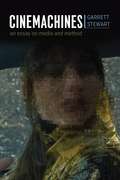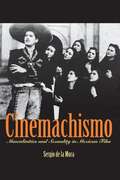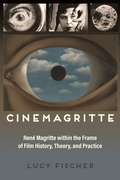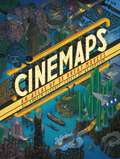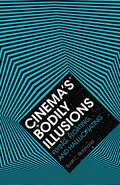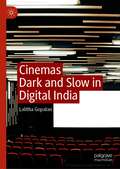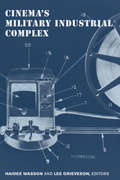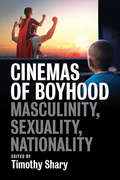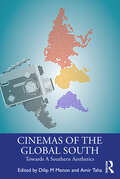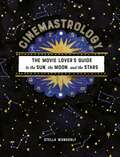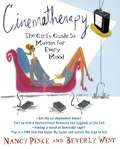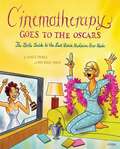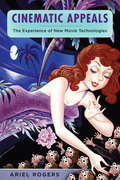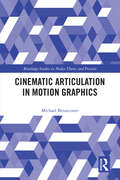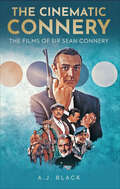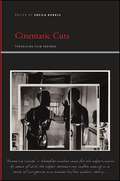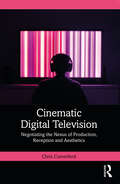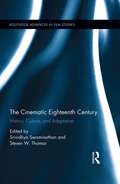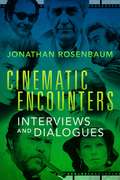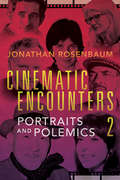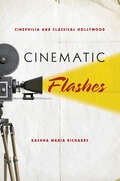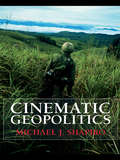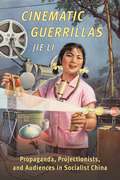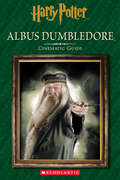- Table View
- List View
Cinemachines: An Essay on Media and Method
by Garrett StewartThe hero stands on stage in high-definition 3-D while doubled on a crude pixel screen in Billy Lynn’s Long Halftime Walk. Alien ships leave Earth by dissolving at the conclusion of Arrival. An illusory death spiral in Vertigo transitions abruptly to a studio set, jolting the spectator. These are a few of the startling visual moments that Garrett Stewart examines in Cinemachines, a compelling, powerful, and witty book about the cultural and mechanical apparatuses that underlie modern cinema. Engaging in fresh ways with revelatory special effects in the history of cinematic storytelling—from Buster Keaton’s breaching of the film screen in Sherlock Jr. to the pixel disintegration of a remotely projected hologram in Blade Runner 2049—Stewart’s book puts unprecedented emphasis on technique in moving image narrative. Complicating and revising the discourse on historical screen processes, Cinemachines will be crucial reading for anyone interested in the evolution of the movies from a celluloid to a digital medium.
Cinemachismo: Masculinities and Sexuality in Mexican Film
by De La Mora SergioHe focuses on three traditional genres (the revolutionary melodrama, the cabaretera [dancehall] prostitution melodrama, and the musical comedy "buddy movie") and one subgenre (the fichera brothel-cabaret comedy) of classic and contemporary cinema. By concentrating on the changing conventions of these genres, de la Mora reveals how Mexican films have both supported and subverted traditional heterosexual norms of Mexican national identity. In particular, his analyses of Mexican cinematic icons Pedro Infante and Gael García Bernal and of Arturo Ripstein's cult film El lugar sin límites illuminate cinema's role in fostering distinct figurations of masculinity, queer spectatorship, and gay male representations. De la Mora completes this exciting interdisciplinary study with an in-depth look at how the Mexican state brought about structural changes in the film industry between 1989 and 1994 through the work of the Mexican Film Institute (IMCINE), paving the way for a renaissance in the national cinema.
Cinemagritte: René Magritte within the Frame of Film History, Theory, and Practice (Contemporary Approaches to Film and Media Series)
by Lucy FischerCinemagritte: René Magritte within the Frame of Film History, Theory, and Practice investigates the dynamic relationship between the Surrealist modernist artist René Magritte (1898–1967) and the cinema—a topic largely ignored in the annals of film and art criticism. Magritte once said that he used cinema as "a trampoline for the imagination," but here author Lucy Fischer reverses that process by using Magritte’s work as a stimulus for an imaginative examination of film. While Fischer considers direct influences of film on Magritte and Magritte on film, she concentrates primarily on "resonances" of Magritte’s work in international cinema—both fiction and documentary, mainstream and experimental. These resonances exist for several reasons. First, Magritte was a lover of cinema and created works as homages to the medium, such as Blue Cinema (1925), which immortalized his childhood movie theater. Second, Magritte’s style, though dependent on bizarre juxtapositions, was characterized by surface realism—which ties it to the nature of the photographic and cinematic image. Third, Magritte shares with film a focus on certain significant concepts: the frame, voyeurism, illusionism, the relation between word and image, the face, montage, variable scale, and flexible point of view. Additionally, the volume explores art documentaries concerning Magritte as well as the artist’s whimsical amateur "home movies," made with his wife, Georgette, friends, and Belgian Surrealist associates. The monograph is richly illustrated with images of Magritte’s oeuvre as well as film stills from such diverse works as The Eternal Sunshine of the Spotless Mind, Eyes Without a Face, American Splendor, The Blood of a Poet, Zorns Lemma, The Island of Dr. Moreau, The Draughtsman’s Contract, and many more. Cinemagritte brings a novel and creative approach to the work of Magritte and both film and art criticism. Students, scholars, and fans of art history and film will enjoy this thoughtful marriage of the two.
Cinemaps: An Atlas of 35 Great Movies
by Andrew Degraff A. D. JamesonThis beautifully illustrated atlas of beloved movies is an essential reference for cinephiles, fans of great films, and anyone who loves the art of mapmaking. Acclaimed artist Andrew DeGraff has created beautiful hand-painted maps of all your favorite films, from King Kong and North by Northwest to The Princess Bride, Fargo, Pulp Fiction, even The Breakfast Club—with the routes of major characters charted in meticulous cartographic detail. Follow Marty McFly through the Hill Valley of 1985, 1955, and 1985 once again as he races Back to the Future. Trail Jack Torrance as he navigates the corridors of the Overlook Hotel in The Shining. And join Indiana Jones on a globe-spanning journey from Nepal to Cairo to London on his quest for the famed Lost Ark. Each map is presented in an 11-by-14-inch format, with key details enlarged for closer inspection, and is accompanied by illuminating essays from film critic A. D. Jameson, who speaks to the unique geographies of each film.
Cinema's Bodily Illusions: Flying, Floating, and Hallucinating
by Scott C. RichmondDo contemporary big-budget blockbuster films like Gravity move something in us that is fundamentally the same as what avant-garde and experimental films have done for more than a century? In a powerful challenge to mainstream film theory, Cinema's Bodily Illusions demonstrates that this is the case. Scott C. Richmond bridges genres and periods by focusing, most palpably, on cinema's power to evoke illusions: feeling like you're flying through space, experiencing 3D without glasses, or even hallucinating. He argues that cinema is, first and foremost, a technology to modulate perception. He presents a theory of cinema as a proprioceptive technology: cinema becomes art by modulating viewers' embodied sense of space. It works primarily not at the level of the intellect but at the level of the body. Richmond develops his theory through examples of direct perceptual illusion in cinema: hallucinatory flicker phenomena in Tony Conrad's The Flicker, eerie depth effects in Marcel Duchamp's Anémic Cinéma, the illusion of bodily movement through onscreen space in Stanley Kubrick's 2001, Godfrey Reggio's Koyaanisqatsi, and Alfonso Cuarón's Gravity. In doing so he combines insights from Maurice Merleau-Ponty's phenomenology of perception and James J. Gibson's ecological approach to perception. The result is his distinctive ecological phenomenology, which allows us to refocus on the cinema's perceptual, rather than representational, power.Arguing against modernist habits of mind in film theory and aesthetics, and the attendant proclamations of cinema's death or irrelevance, Richmond demonstrates that cinema's proprioceptive aesthetics make it an urgent site of contemporary inquiry.
Cinemas Dark and Slow in Digital India
by Lalitha GopalanThis book provides a sustained engagement with contemporary Indian feature films from outside the mainstream, including Aaranaya Kaandam, I.D., Kaul, Chauthi Koot, Cosmic Sex, and Gaali Beeja, to undercut the dominance of Bollywood focused film studies. Gopalan assembles films from Bangalore, Chennai, Delhi, Kolkata, and Trivandrum, in addition to independent productions in Bombay cinema, as a way of privileging understudied works that deserve critical attention. The book uses close readings of films and a deep investigation of film style to draw attention to the advent of digital technologies while remaining fully cognizant of ‘the digital’ as a cryptic formulation for considering the sea change in the global circulation of film and finance. This dual focus on both the techno-material conditions of Indian cinema and the film narrative offers a fulsome picture of changing narratives and shifting genres and styles.
Cinema's Military Industrial Complex
by Haidee Wasson Lee GrievesonThe vast and influential American military has been aided and abetted by cinema since the earliest days of the medium. The army, navy, and air force put films to work in myriad ways, enlisting them to entertain, train, and heal soldiers as well as to propagandize, strategize, spy, map, and develop weapons, from rifles to atomic bombs. Presenting new essays based on archival research, Cinema’s Military Industrial Complex addresses the relationship of military cinema to Hollywood, technological innovation, new modes of filmmaking, unique film styles and genres, and the rise of American soft power across the long twentieth century. This rich and timely volume is essential for scholars interested in the military’s use of media and the exercise of influence within and beyond American borders.
Cinemas of Boyhood: Masculinity, Sexuality, Nationality
by Timothy SharyDrawing from political sociology, pop psychology, and film studies, Cinemas of Boyhood explores the important yet often overlooked subject of boys and boyhood in film. This collected volume features an eclectic range of films from British and Indian cinemas to silent Hollywood and the new Hollywood of the 1980s, culminating in a comprehensive overview of the diverse concerns surrounding representations of boyhood in film.
Cinemas of the Global South: Towards a Southern Aesthetics
by Dilip M Menon Amir TahaThis book engages with the idea of the Global South through cinema as a concept of resistance; as a space of decolonialisation; and as an arena of virtuality, creativity and change. It opens up a dialogue amongst scholars and filmmakers from the Global South: India, Nigeria, Colombia, Brazil, South Africa, and Egypt.The essays in the volume approach cinema as an intertwined process of both production and perception not divorced from the economic, social, political and cultural. They emphasise film as a visual medium where form, structure and content are not separable. Through a wide array of film-readings, the authors explore the concept of a southern cinematic esthetics, in particular, and the concept of the Global South in general.The volume will be of interest to scholars, students and researchers of film and media studies, critical theory, cultural studies and Global South studies.
Cinemastrology: The Movie Lover's Guide to the Sun, the Moon, and the Stars
by Stella WonderlyPicking your perfect flick can be an overwhelming experience. But fear not! Cinemastrology answers a question that has stumped even the most avid film buff for over a century: "What movie should I watch?"From contemporary comedies to Hollywood classics, from date movies to adrenaline fests, Cinemastrology is your guide to the art of selecting viewing based on your astrological sign. It includes profiles of all the sun signs and offers an extensive list of movie recommendations for each, complete with descriptions, behind-the-scenes stories, and insights into the unique qualities of each sign, from Aries to Pisces. Sections covering the stars that light up the screen and sign-compatible suggestions based on the sign of your partner or film-viewing friend round out Cinemastrology.Getting started is easy! All you need is a birthday and a passion for movies.
Cinematherapy: The Girl's Guide to Movies For Every Mood
by Beverly West Nancy PeskeWhat can take the edge off a bad day at the office better than a movie where the boss gets his (9-5)? And, of course, that close-up of Antonio Banderas, wet and naked in a cage, is the best cure for the break-up blahs known to modern science (Never Talk to Strangers). Now, for the first time, Cinematherapy acknowledges what women have known for years, and provides a sage guide to the best movie medicine currently available for whatever ails you, whether it's a sudden hormonal shift, a bad-hair day, or a full-fledged identity crisis.
Cinematherapy Goes to the Oscars
by Nancy Peske Beverly WestGet ready for some of the best movie medicine ever made. The smash hit women's film guide Cinematherapy taught women that comfort, self-acceptance, inspiration, and humor were no farther away than the video store - and inspired the daily prime-time show on the WE Network (Women's Entertainment). Now the authors are back with a Cinematherapy take on the Oscar canon and how these award-winning films serve not only as a celluloid pharmacy but also as a window into ourselves, our relationships, and our times. Starting with the present and working backward by decade, Cinematherapy Goes to the Oscars uncovers the grand themes of each decade's award-winning films, from the Father Issue films of the seventies, with their ambiguous father figures (Patton, Kramer vs. Kramer) to bad girls acting out for disapproving fathers' love (Klute, Cabaret), to the Unsung Hero films of the fifties (On the Waterfront, The African Queen). Along the way there is great dish on who wore what on the Red Carpet, who said what in their acceptance speeches, and party tips for throwing a four-star Oscar bash, as well as returning popular sidebars like the Handy Hunk Chart. As the first female take on these sacred cows of the Silver Screen, focusing on the moments, messages, leading ladies, and supporting men that matter to us most, Cinematherapy Goes to the Oscars is the ultimate indulgence for every woman ready to curl up and take charge of her own remote control.
Cinematic Appeals: The Experience of New Movie Technologies (Film and Culture Series)
by Ariel RogersCinematic Appeals follows the effect of technological innovation on the cinema experience, specifically the introduction of widescreen and stereoscopic 3D systems in the 1950s, the rise of digital cinema in the 1990s, and the transition to digital 3D since 2005. Widescreen cinema promised to draw the viewer into the world of the screen, enabling larger-than-life close-ups of already larger-than-life actors. This technology fostered the illusion of physically entering a film, enhancing the semblance of realism. Alternatively, the digital era was less concerned with the viewer's physical response and more with information flow, awe, and the reevaluation of spatiality and embodiment. This study ultimately shows how cinematic technology and the human experience shape and respond to each other over time.
Cinematic Appeals
by Ariel RogersCinematic Appeals follows the effect of technological innovation on the cinema experience, specifically the introduction of widescreen and stereoscopic 3D systems in the 1950s, the rise of digital cinema in the 1990s, and the transition to digital 3D since 2005. Widescreen films drew the spectator into the world of the screen, enabling larger-than-life close-ups of already larger-than-life actors. The technology fostered the illusion of physically entering a film, enhancing the semblance of realism. Alternatively, the digital era was less concerned with manipulating the viewer's physical response and more with generating information flow, awe, disorientation, and the disintegration of spatial boundaries. This study ultimately shows how cinematic technology and the human experience shape and respond to each other over time. Films discussed include Elia Kazan's East of Eden (1955), Star Wars: Phantom Menace (1999), The Matrix (1999), and Thomas Vinterberg's Dogme film Celebration (1995).
Cinematic Articulation in Motion Graphics (Routledge Studies in Media Theory and Practice)
by Michael BetancourtThis book develops a critical and theoretical approach to the semiotics of motion pictures as they are applied to a broader range of constructions than traditional commercial narrative productions. This interdisciplinary approach begins with the problems posed by motion perception to develop a model of cinematic interpretation that includes both narrative and non-narrative types of productions. Contrasting traditional theatrical projection and varieties of new media, this book integrates analyses of title sequences, music videos, and visual effects with discussions on classic and avant-garde films. It further explores the intersection between formative audio-visual cues identified by viewers and how viewers’ desires direct engagement with the motion picture to present a framework for understanding cinematic articulation. This new theoretical model incorporates much of what was neglected and gives greater prominence to formerly critical marginal productions by showing the fundamental connections that link all moving imagery and text, whether it tells a story or not. This insightful work will appeal to students and academics in film and media studies.
The Cinematic Connery: The Films of Sir Sean Connery
by A. J. BlackScotland’s greatest export. The world’s first super spy. Voted the sexiest man on the planet. Sir Sean Connery was a titanic figure on screen and off for over half a century. Behind the son of a factory worker, growing up in near-poverty on the harsh streets of pre-war Edinburgh, lay a timeless array of motion pictures that spanned multiple decades and saw Connery work across the globe with directors as diverse as Alfred Hitchcock, Steven Spielberg and Michael Bay. And amongst them his greatest role, whether he liked it or not – Bond, James Bond. Author A. J. Black delves into Connery’s life for more than mere biography, exploring not just the enormously varied pictures he made including crowd pleasing blockbusters such as The Untouchables or Indiana Jones and the Last Crusade, serious-minded fare in The Hill or The Offence, and his strange sojourns into eclectic fantasy with Zardoz or Time Bandits, but also the sweep of a career that crossed movie eras as well as decades. From skirmishes with the angry young men of the British New Wave, via becoming the cinematic icon of the 1960s as 007, through to a challenging reinvention as a unique older actor of stature in the 1980s, this exploration of the Cinematic Connery shows just how much his work reflected the changing movie-going tastes, political realities and cultural trends of the 20th century, and beyond . . .
Cinematic Cuts: Theorizing Film Endings (SUNY series, Insinuations: Philosophy, Psychoanalysis, Literature)
by Sheila KunkleEditing has been called the language of cinema, and thus a film's ending can be considered the final punctuation mark of this language, framing everything that came before and offering the key to both our interpretation and our enjoyment of a film. In Cinematic Cuts, scholars explore the philosophical, literary, and psychoanalytic significance of film endings, analyzing how film endings engage our fantasies of cheating death, finding true love, or determining the meaning of life. They examine how endings offer various forms of enjoyment for the spectator, from the momentary fulfillment of desire in the happy ending to the pleasurable torment of an indeterminate ending. The contributors also consider how film endings open onto larger questions relating to endings in our time. They suggest how a film ending's hidden counternarrative can be read as a political act, how our interpretation of a film ending parallels the end of a psychoanalytical session, how film endings reveal our anxieties and fears, and how cinema itself might end with the increasing intervention of digital technologies that reorient the spectator's sense of temporality and closure. Films by Akira Kurosawa, Lars von Trier, Joon-Hwan Jang, Claire Denis, Christopher Nolan, Jane Campion, John Huston, and Spike Jonze, among others, are discussed.
Cinematic Digital Television: Negotiating the Nexus of Production, Reception and Aesthetics
by Chris ComerfordChris Comerford explores cinematic digital television as an artistic classification and an academic object of study, and illuminates the slippage in definitions of previously understood media forms. The growth of television as an artistic, informative medium has given rise to shifts in the aesthetic style of the programmes we watch, and this book outlines these shifts along with the contemporary debates and critical theory surrounding them. Comerford looks at the forms and aesthetics of television, the production standards influencing streaming television and the agency of audiences, and provides case studies of key TV shows illustrating these shifts, including Twin Peaks: The Return, WandaVision, Hacks and Russian Doll. Navigating the levels of production and reception in cinematic digital television, the book uses film-inspired TV as a lightning rod for understanding our narrative screen media landscape and the classifications we use to negotiate it. As an essential reading for both scholars and students of media and television studies, this book provides a much-needed consideration of the changing landscape of television.
The Cinematic Eighteenth Century: History, Culture, and Adaptation (Routledge Advances in Film Studies)
by Srividhya Swaminathan Steven W. ThomasThis collection explores how film and television depict the complex and diverse milieu of the eighteenth century as a literary, historical, and cultural space. Topics range from adaptations of Austen’s Sense and Sensibility and Defoe's Robinson Crusoe (The Martian) to historical fiction on the subjects of slavery (Belle), piracy (Crossbones and Black Sails), monarchy (The Madness of King George and The Libertine), print culture (Blackadder and National Treasure), and the role of women (Marie Antoinette, The Duchess, and Outlander). This interdisciplinary collection draws from film theory and literary theory to discuss how film and television allows for critical re-visioning as well as revising of the cultural concepts in literary and extra-literary writing about the historical period.
Cinematic Encounters: Interviews and Dialogues
by Jonathan RosenbaumGodard. Fuller. Rivette. Endfield. Tarr. In his celebrated career as a film critic, Jonathan Rosenbaum has undertaken wide-ranging dialogues with many of the most daring and important auteurs of our time. Cinematic Encounters collects more than forty years of interviews that embrace Rosenbaum's vision of film criticism as a collaboration involving multiple voices. Rosenbaum accompanies Orson Welles on a journey back to Heart of Darkness , the unmade film meant to be Welles's Hollywood debut. Jacques Tati addresses the primacy of décor and soundtrack in his comedic masterpiece PlayTime, while Jim Jarmusch explains the influence of real and Hollywoodized Native Americans in Dead Man. By arranging the chapters chronologically, Rosenbaum invites readers to pursue thematic threads as if the discussions were dialogues between separate interviews. The result is a rare gathering of filmmakers trading thoughts on art and process, on great works and false starts, and on actors and intimate moments.
Cinematic Encounters 2: Portraits and Polemics
by Jonathan RosenbaumEschewing the idea of film reviewer-as-solitary-expert, Jonathan Rosenbaum continues to advance his belief that a critic's ideal role is to mediate and facilitate our public discussion of cinema. Portraits and Polemics presents debate as an important form of cinematic encounter whether one argues with filmmakers themselves, on behalf of their work, or with one's self. Rosenbaum takes on filmmakers like Chantal Akerman, Richard Linklater, Manoel De Oliveira, Mark Rappaport, Elaine May, and Béla Tarr. He also engages, implicitly and explicitly, with other writers, arguing with Pauline Kael--and Wikipedia--over Jacques Demy, with the Hollywood Reporter and Variety reviewers of Jarmusch’s The Limits of Control, with David Thomson about James L. Brooks, and with many American and English film critics about misrepresented figures from Jerry Lewis to Yasujiro Ozu to Orson Welles. Throughout, Rosenbaum mines insights, pursues pet notions, and invites readers to join the fray.
Cinematic Flashes: Cinephilia and Classical Hollywood
by Rashna Wadia RichardsCinematic Flashes challenges popular notions of a uniform Hollywood style by disclosing uncanny networks of incongruities, coincidences, and contingencies at the margins of the cinematic frame. In an agile demonstration of "cinephiliac" historiography, Rashna Wadia Richards extracts intriguing film fragments from their seemingly ordinary narratives in order to explore what these unexpected moments reveal about the studio era. Inspired by Walter Benjamin's preference for studying cultural fragments rather than composing grand narratives, this unorthodox history of the films of the studio system reveals how classical Hollywood emerges as a disjointed network of accidents, excesses, and coincidences.
Cinematic Geopolitics
by Michael J. ShapiroIn recent years, film has been one of the major genres within which the imaginaries involved in mapping the geopolitical world have been represented and reflected upon. In this book, one of America's foremost theorists of culture and politics treats those aspects of the "geopolitical aesthetic" that must be addressed in light of both the post cold war and post 9/11 world and contemporary film theory and philosophy. Beginning with an account of his experience as a juror at film festival’s, Michael J. Shapiro’s Cinematic Geopolitics analyzes the ways in which film festival space and both feature and documentary films function as counter-spaces to the contemporary "violent cartography" occasioned by governmental policy, especially the current "war on terror." Influenced by the cinema-philosophy relationship developed by Gilles Deleuze and the politics of aesthetics thinking of Jacques Ranciere, the book’s chapters examines a range of films from established classics like the Deer Hunter and the Battle of Algiers to contemporary films such as Dirty Pretty Things and the Fog of War. Shapiro’s use of philosophical and theoretical works makes this cutting edge examination of film and politics essential reading for all students and scholars with an interest in film and politics.
Cinematic Guerrillas: Propaganda, Projectionists, and Audiences in Socialist China
by Jie LiHow might cinema make revolution and mobilize the masses? In socialist China, the film exhibition network expanded from fewer than six hundred movie theaters to more than a hundred thousand mobile film projectionist teams. Holding screenings in improvised open-air spaces in rural areas lacking electricity, these roving projectionists brought not only films but also power generators, loudspeakers, slideshows, posters, live performances, and mass ritual participation, amplifying the era’s utopian dreams and violent upheavals.Cinematic Guerrillas is a media history of Chinese film exhibition and reception that offers fresh insights into the powers and limits of propaganda. Drawing on a wealth of archives, memoirs, interviews, and ethnographic fieldwork, Jie Li examines the media networks and environments, discourses and practices, experiences and memories of film projectionists and their grassroots audiences from the 1940s to the 1980s. She considers the ideology and practice of “cinematic guerrillas”—at once denoting onscreen militants, off-the-grid movie teams, and unruly moviegoers—bridging Maoist iconography, the experiences of projectionists, and popular participation and resistance. Li reconceptualizes socialist media practices as “revolutionary spirit mediumship” that aimed to turn audiences into congregations, contribute to the Mao cult, convert skeptics of revolutionary miracles, and exorcize class enemies.Cinematic Guerrillas considers cinema’s meanings for revolution and nation building; successive generations of projectionists; workers, peasants, and soldiers; women and ethnic minorities; and national leaders, local cadres, and cultural censors. By reading diverse, vivid, and often surprising accounts of moviegoing, Li excavates Chinese media theories that provide a critical new perspective on world cinema.
Cinematic Guide: Albus Dumbledore (Harry Potter)
by Felicity BakerThe Essential Film Companion for ALBUS DUMBLEDORE that's perfect for the youngest fans! This hardcover guidebook features your favorite scenes and quotes from all eight Harry Potter movies!The experience of this eBook will be best if viewed on a tablet.
